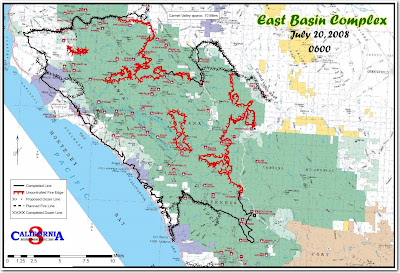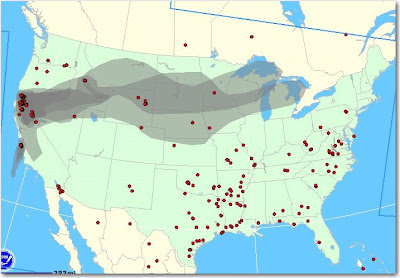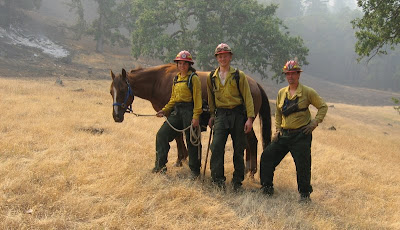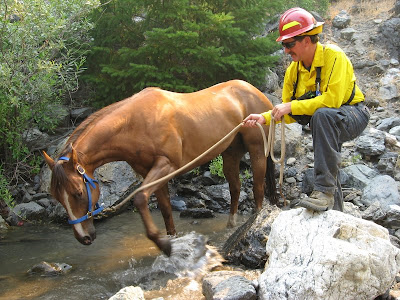President plans flightseeing trip over firesPresident Bush is expected to fly in to the Redding, California airport around 2 p.m. today. Then he and the Governor will cruise around in a helicopter looking at the fires. This will be the first time a sitting president has visited Redding since John F. Kennedy was there in 1963 for the dedication of the Whiskeytown Dam.
Bush will also attend a private Republican fund raiser in Napa.
UPDATE @ 2026 PT, July 17
A reporter for the Redding Record Searchlight, Ryan Sabalow, was at the Redding airport for the President's visit and was using his Blackberry to send
live updates to the newspaper. Here is his description of when the President stopped by to see the jumpers:
Prez Bush just walked into smokejumper room. Walked up to John Casey, a 38-year-old jumper with almost 200 jumps in his career.
"I couldn't handle it," he said to Casey.
Bush asked him how many jumps. His eyes got wide at the number -- 200.
"I appreciate your service," Bush said.
Bush went around the room shaking hands and greeting the smokejumpers, who appeared busy sewing and prepping their chutes.
One was so fixed on his work that he apparently missed the president's approach from behind.
"I don't want to interrupt," Bush said, drawing laughter from reporters and firefighters alike.
Gov followed being giving kudos to the firefighters.
"Good to see you," he said to Casey. "Keep up the good work."
UPDATE @ 1413 PT, July 17:
Here is part of a
transcript from a "press gaggle" that occurred today at 10:55 p.m. PT on Air Force One on the way to Redding, California. Mr. Stanzel is a spokesperson for the President. Under Secretary of Agriculture Mark Rey also participated in the gaggle.
Mr. STANZEL: At 2:30 p.m. today, when we arrive in California, the President will participate in a briefing on the California wildfires. That will be at -- in Redding, California. We'll have pool at the top, and he'll receive a briefing on the response efforts from federal, state and local officials.
And as you -- I'll let the two experts here talk a little bit about the fires themselves, but I would just note that on June 28th, the President signed an emergency declaration for the state of California; that is providing federal funding and support. And we have lots of information about the fires, and these are the single-largest -- this is the single-largest fire event in the history of California with over 1,300 square miles burned since June 21st.
After the President participates in that briefing on the California wildfires, he is going to participate in an aerial tour of the area, of Redding, and he will be joined in that by Governor Schwarzenegger. Administrator Paulison will also be there for an aerial tour of the Shasta-Trinity National Forest. And following the aerial tour, the -- Governor Schwarzenegger and the President will deliver brief remarks.
[...]
Q And square miles burned?
UNDER SECRETARY REY: I was afraid you were going to ask square miles burned -- it's about 900,000 acres burned. I'd have to get you the -- it's 66 acres per square mile, so -- (laughter) -- if you want the divide that number by 66 --
Q Can you give us an idea of what he'll see in the aerial tour?
UNDER SECRETARY REY: What he'll see in the aerial tour is areas of the Shasta-Trinity National Forest that have burned, as well as areas that have been thinned to reduce flammable materials. He'll also see a couple of thinning projects that did result in our ability to put out a fire more easily.
[...]
UNDER SECRETARY REY: Let me correct a number I gave you. It's 640 acres per square mile. So I've got to remember that. I have a hard time with the metric system and all that sort of stuff. I don't trust it.
The President will be briefed at the U.S. Forest Service smoke jumper base before he departs for his flightseeing tour. He will meet with Cal Fire Chief Ruben Garijalva, Randy Moore, U.S. Forest Service Regional Forester, Gen. William Wade from the National Guard, and Henry Renteria, director of the California Office of Emergency Services. After his briefing he will visit the smokejumper loft and say hello to the jumpers working on their chutes before he departs on a helicopter for a tour of the Shasta-Trinity National Forest.
Basin fire, Big Sur areaThe satellites have detected quite a bit of heat north and south of the White Oaks area that is outside of yesterday's fire perimeter, apparently the result of quite a bit of firing from the dozer lines. The update from the fire late yesterday had this information:
Today's burnout operations went well on Chew's Ridge. Burning conditions were optimal and a combination of tools, including the helitorch, was used to meet today's objectives. It is expected that operations will extend east along the containment line to Carmel Valley Road tonight. Burnout operations in this area will continue through the coming days as weather conditions permit.
At the south end of the fire, along Carrizo Trail, the Cobra helicopter that is outfitted with an infrared camera found no remaining hotspots near the containment line.
Burnout operations also continued east of Devil's Peak on the north edge of the fire, and will continue in the coming days as conditions permit.
The King City Incident Command Post and Carmel Valley Spike Camp have been combined and relocated to Carmel Valley Road near Tassajara Road.
At a public meeting Tuesday night a Forest Service spokesman used technical jargon to explain the slopover in the White Oaks area:
"Two nights ago, we had a little oops," Buck Silva of the U.S. Forest Service told a group of more than 100 residents at a community meeting late Tuesday at Tularcitos Elementary School in Carmel Valley.
"We're making progress," he said. "We just had this little pooch-out that delayed us a couple of days."
I can't find
"a little oops" or
"pooch-out" in the glossary in the Fireline Handbook.
The fire is 122,980 acres and is 61% contained. The map below is of the White Oaks area.

This map shows how much heat (in red) was detected by the satellites outside the last perimeter (in yellow) uploaded by the incident management team. I am going to assume that all of the heat shown shown outside the perimeter, including that on the northeast side in the White Oaks area, was created by the burnouts from the dozer lines.
 Cold Springs fire, Mt. Adams, Washington
Cold Springs fire, Mt. Adams, WashingtonThe spread of the Cold Springs fire on the lower slopes of Mt. Adams in southwest Washington has slowed. After quickly burning over 7,000 acres, it is now about 7,900 acres. Yesterday morning it was 5% contained, but that percentage has increased since then.
 The map shows that the firefighters have completed firing out from the dozer lines around the White Oaks slopover north of the Mira Observatory. One of the higher priorities they are working on now is burning out from the dozer lines just north of Arroyo Seco.
The map shows that the firefighters have completed firing out from the dozer lines around the White Oaks slopover north of the Mira Observatory. One of the higher priorities they are working on now is burning out from the dozer lines just north of Arroyo Seco.











